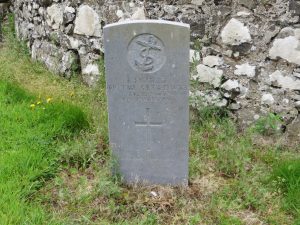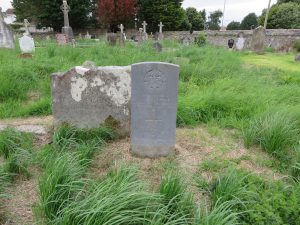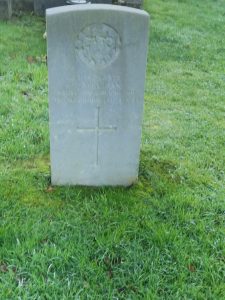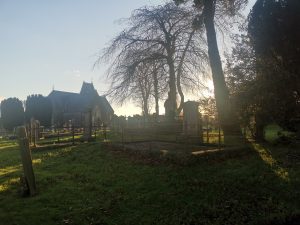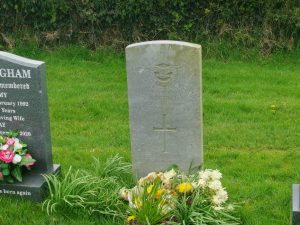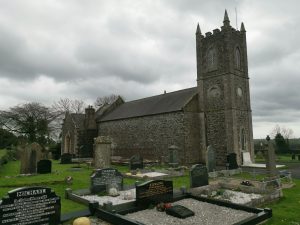Diamond, J (Joseph)

Rifleman Joseph Diamond was the husband of Mary Anne Diamond, of 1, Lower Kerr St., Portrush, Co. Antrim. He had at least four sons and two daughters. The boys were Michael, Joseph, Thomas and Robert and the daughters Mary and Catherine.
Joseph worked in the transport section of the 12th Battalion, Royal Irish Rifles and originally landed in France with the battalion on the 4th/5th October 1915 in Boulogne.[1] They then moved to a rest camp before departing by train to Flesselles[2] and then marching to Pierregot.[3] Here they drilled and trained before moving onto Hédauville[4] for a week’s training in trench warfare.
While in the trenches, B Company received their first casualties, they were Rifleman Samuel Hill,[5] Rifleman John McCabe,[6] and Rifleman David McNeilly,[7] of B Company and Rifleman Hugh Patton[8] and Jackson McCaughan[9] of D Company. Afterwards they left for Bernaville[10] and Vauchelles-les-Quesnoy[11] for training, rest, and more trench experience. They remained at the latter throughout December and into January when they moved to Ribeaucourt.[12] Casualties remained extremely low.
The situation remained much the same during the beginning of 1916. The battalion moved from sector to sector, manned trenches, trained, patrolled, and continued to have low casualties. Every day they gained more and more experience in modern trench warfare and by the beginning of June, they found themselves in billets Léalvillers,[13] and Mesnil-Martinsart,[14] for rest and attack practice. By the 29th of June they were back in the trenches and relieved the 9th Royal Irish Fusiliers in the Hamel sub-sector. Orders had already arrived for an attack on the 1st of July.
Along with the 9th Royal Irish Fusiliers, the 12th Royal Irish Rifles were to attack on the right bank of the river Ancre after a lengthy 5-day bombardment from their artillery. Confidence was so high for success that orders were given not to drink the German’s water, until the source could be tested by a medical officer, just in case it was tainted. Their goal was to reach the trenches guarding Beaucourt Railway Station.
At 7:10 am the first of four waves of the 9th Royal Irish Fusiliers took off towards the German lines in intervals, the last leaving at 7:30 am. The first wave advanced with very few casualties through the wire but as they reached the ravine machine gun fire ripped through them and casualties were numerous. The 2nd, 3rd and 4th waves met the machinegun fire as they advanced through their barbed wire. The 3rd and 4th also received mortar and shelling casualties. Two platoons from the 12th Royal Irish Rifles were in support, but they also did not get far when they were ripped apart while going through the gaps in their own wire.
At the same time, the rest of the 12th Royal Irish Rifles were advancing, they also met with machine gun fire and shelling but as with the 9th Fusiliers some men reached the first German line and met with some resistance. The 2nd German line though had been heavily reinforced, and the Germans now stood above their trenches, firing, and throwing bombs at the remaining men of the two battalions. As no support was coming the men had to retire from the situation and withdraw to the Sunken Road.
At 10:12 am, the men were once again ordered to attack. Around 100 men were available but were beaten back by machine gun fire and shelling. Another order arrived for an attack at 12:30 pm. There was now only 46 men. Word was sent back, and the attack was cancelled. The soldiers now returned to their trenches.
The following day, only 126 men of the 12th Royal Irish Rifles marched away from the area from the 900 plus who arrived. This included troops who took no part in the advance. Of the 615 men of the 9th Royal Irish Fusiliers who went “over the top”, 535 were now dead, wounded or missing.
Rifleman Joseph Diamond survived that day and remained with the battalion until January 1918 when he fell ill. He was later sent to a hospital in Leeds and passed away on the 9th, reasons presently unknown. Within a few months his battalion would once again be decimated after being surrounded by the Germans. On the 31st of March 1918, there were only 112 men left. The rest were dead, wounded or captured.
Joseph’s[15] second son, who had the same name as him, served with the 1st Battalion, Royal Irish Rifles. He was given compassionate leave to attend his father’s funeral and then returned to the front line, only to be wounded in the next few weeks. He would survive this only to be killed on the 7th of May 1918.
Joseph was awarded the 1914/15 Star, the British War and Victory Medals.
Date of Death: 09/02/1918 (Aged 46)
Service: Rifleman, 12th Battalion Royal Irish Rifles
Service Number: 12/2803
Burial Location: Ballywillan Cemetery, E. 20 (South-East part).
[1] Boulogne or Boulogne-sur-Mer is a fishing port located on the northern coast of France.
[2] Flesselles in an area in France around 60 miles south, southeast from Boulogne.
[3] Pierregot is around 6 miles to the east of Flesselles.
[4] Hédauville is about 10 miles to the east of Pierregot.
[5] Rifleman Samuel Hill, 19557 of Whitehouse, Belfast, passed away on the 22nd of October 1915. He had shrapnel wounds to the head. He now rests in Doullens Communal Cemetery Extension No.1. His brother, Alexander was lost at Sea in 1917 on board H.M.S Princess Alberta. Samuel was the first man of the 12th Battalion to die in active service.
[6] Rifleman John McCabe, (service number 6111 & 663254) of Carrickfergus received shrapnel wounds to the head on the 23rd of Oct 1915. He would later transfer to the Labour Corps and ultimately survived the war.
[7] Rifleman David McNeilly, (service number 382) was wounded between the 22nd and 24th. He ultimately would survive the war.
[8] Rifleman Hugh Patton, (service number 18623) of Bushmills was wounded between the 22nd and 24th. He would though lose his life during the 16th of Aug 1917 and has no known resting place.
[9] Jackson McCaughan, (service number 2749) of Bushmills was wounded between the 22nd and 24th. He would return to duty only to lose his life during the “Great Assault” at the Somme on the 1st of July 1916. He has no final resting place and is remembered on The Thiepval Memorial.
[10] Bernaville is 21 miles west of Hédauville.
[11] Vauchelles-les-Quesnoy is around 14 miles to the west of Bernaville.
[12] Ribeaucourt is 11 miles east of Vauchelles-les-Quesnoy.
[13] Léalvillers is around 21 miles to the east of Ribeaucourt.
[14] Mesnil-Martinsart is about 7 miles to the east of Léalvillers.
[15] Rifleman Joseph Diamond (service number 1748.) Killed in action on the 7th of May 1918, now resting in Gwalia Cemetery in Belgium. He is officially listed as being 22 when he passed away, he was though only 18.
